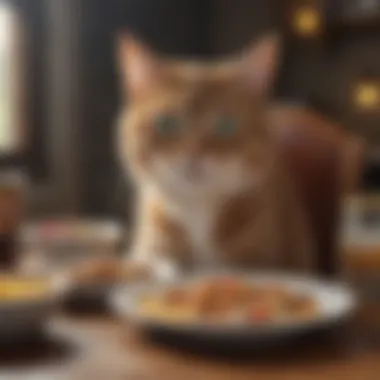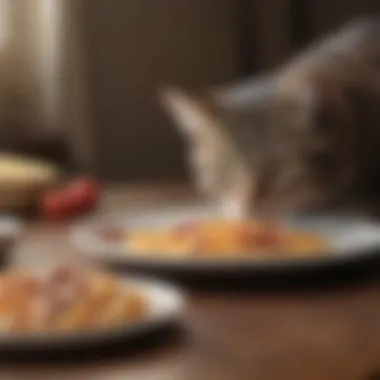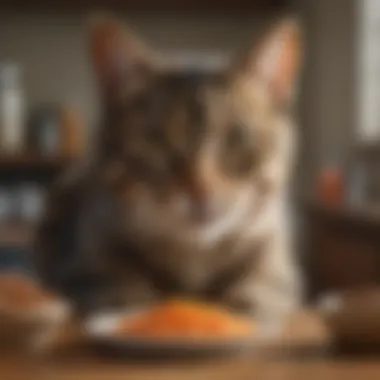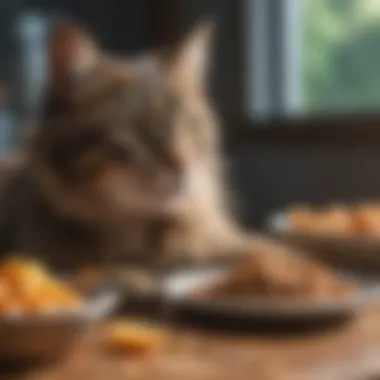Nourishing Diabetic Cats: Dietary Needs Explained


Intro
Managing the health of a diabetic cat is akin to walking a tightrope. One wrong move regarding diet can have significant implications for their well-being. Most cat owners, regardless of experience, feel a sense of urgency when faced with the diagnosis of feline diabetes. It's essential to grasp that nutrition plays a pivotal role in not only managing diabetes but also optimizing the overall health of your four-legged friend.
Cats are obligate carnivores, which means that they rely heavily on protein for their energy needs. However, diabetes complicates this need, requiring owners to navigate through food choices that will help stabilize their furry companions’ blood sugar levels. By understanding the nuances of their dietary needs, one can foster a successful management plan. In this guide, we'll break down the essentials of feeding diabetic cats—what to look for, what to avoid, and how to make informed choices.
Key Points to Discuss
- Understanding diabetes in cats: Grasp the roots of the ailment and its impact on dietary needs.
- Essential nutrients: Identify what nutrients are crucial for diabetic cats.
- Food options: Differentiate between commercial brands and homemade recipes.
- Feeding strategies: Explore various methods of feeding that support stable blood sugar levels.
By delving deep into these components, we aim to equip cat owners with the knowledge to navigate the often murky waters of managing a diabetic cat's diet.
Understanding Feline Diabetes
Understanding diabetes in cats is crucial for cat owners and veterinarians alike. It is not just about recognizing the condition; it's about comprehending its nuances and its impact on diet and overall well-being. Feline diabetes is a growing concern, affecting a significant number of household cats and leading to various health complications if not properly managed. Therefore, this section aims to provide a comprehensive overview of what diabetes means for our felines and how it necessitates a particular dietary approach.
What is Diabetes in Cats?
At its core, diabetes in cats is a metabolic disorder where the cat's body is either unable to produce enough insulin or cannot effectively use the insulin it produces. Insulin is vital for converting glucose from food into energy. When a cat has diabetes, glucose builds up in the blood, leading to high blood sugar levels which can cause a host of health issues.
There are two primary types of diabetes seen in cats. Understanding these types is beneficial for tailoring dietary needs effectively.
Types of Diabetes Affecting Cats
- Type 1 Diabetes: This type occurs when the pancreas fails to produce insulin. It's less common in cats compared to other mammals. The body's normal response to glucose is disrupted, creating a dependency on insulin injections.
- Type 2 Diabetes: More prevalent in cats, this form arises when the body becomes resistant to insulin. Often, it ties back to obesity and poor diet, which makes managing this type through nutrition all the more critical.
Recognizing these types aids cat owners in making informed choices about their pets' diet and lifestyle, which can be pivotal in managing diabetes effectively.
Signs and Symptoms of Diabetes
Identifying diabetes early can make a world of difference. Here are some common signs and symptoms that cat owners should keep an eye out for:
- Increased thirst and urination
- Unexplained weight loss despite a good appetite
- Lethargy and decreased activity levels
- Poor coat condition
- Frequent infections (like urinary tract infections)
If any of these indicators are present, it is vital to consult a veterinarian for proper tests and diagnosis.
"Early detection is the golden ticket to effectively managing feline diabetes, making it essential for owners to recognize the signs."
By understanding the nature of feline diabetes, types, and symptoms, cat owners can take proactive steps to foster better health for their furry companions. This foundation sets the stage for discussing the significant role that nutrition plays in managing and living with this condition.
The Role of Nutrition in Managing Diabetes
When it comes to managing diabetes in our feline friends, nutrition plays a starring role. A well-balanced diet is crucial for diabetic cats, influencing their overall health and energy levels. Unlike typical cats, those with diabetes require a specific dietary regimen to help regulate their blood sugar levels and maintain a healthy weight. Factor in the importance of avoiding potential complications, and it's clear why understanding nutrition is paramount.
Why Diet is Critical for Diabetic Cats
Tailoring diet is essential. Diabetic cats can develop insulin resistance, meaning their body struggles to process sugar effectively. That's where diet kicks in. A proper feeding plan can prevent spikes in blood sugar, thus minimizing the risks associated with the disease. Some immediate benefits of a well-formulated diet include:
- Stable blood sugar levels: Foods rich in protein and low in carbohydrates encourage a consistent glucose level.
- Weight management: A controlled diet supports weight loss in overweight cats, which is often crucial for those with diabetes.
- Improved energy: Correct nutrient balance helps in sustaining the cat’s energy, allowing her to remain playful and engaged.
Remember, choosing the right type of food is half the battle. High-quality protein sources such as chicken, turkey, or fish are generally recommended for their low carbohydrate content, all while providing necessary amino acids. However, always consult your veterinarian to personalize the approach based on individual needs. Diet isn't just about feeding; it's a proactive measure to safeguard against complications.
Factors Influencing Nutrition Needs
Understanding that each cat is unique is vital. Several factors influence the dietary requirements of diabetic felines:
- Age: Age can determine metabolism. Younger, active cats might need different food types compared to senior felines who may be less active.
- Weight: Overweight cats naturally have different needs than their lean counterparts. Weight management requires a stricter, tailored regimen.
- Individual health conditions: Other existing conditions such as kidney disease or hyperthyroidism can also dictate specific dietary restrictions or needs, necessitating a tailored focus on certain nutrients.
- Activity level: Active cats may require higher protein and fat to support their energy expenditure compared to those who are more sedentary.
A well-planned diet tailored to your diabetic cat’s specific needs can lead to noticeable improvements in her health and quality of life.
Crafting a dietary plan for your diabetic cat involves considering all these factors, helping create a balanced meal plan that caters to her unique needs. Always keeping the focus on their specific health status will ultimately yield the best results.


Key Nutritional Components
Understanding the key nutritional components that play a vital role in managing diabetes in cats is crucial for any pet owner. Felines with diabetes require a diet that accommodates their unique metabolic needs. The right balance of protein, carbohydrates, and fats can make all the difference in managing their health. Not only do these dietary elements provide energy, but they also contribute to overall health and well-being. As you embark on this journey of nutrition for your diabetic cat, it is essential to recognize how each component interacts with their condition, paving the way for better outcomes.
The Importance of Protein
Protein is often considered the backbone of a diabetic cat's diet. Cats are obligate carnivores, which means they have evolved to thrive on animal protein. High-quality protein not only supports muscle maintenance but also encourages healthy organ function. When it comes to diabetic cats, protein can help stabilize blood sugar levels. This stabilization is handy in preventing spikes that could lead to complications. It's worth noting that not all proteins are created equal. Opting for animal-based proteins like chicken, turkey, and fish can provide the necessary amino acids that your feline friend needs. A good protein content in the diet helps create a sense of fullness, which can reduce the temptation to overeat.
"A diet that prioritizes high-quality protein can keep your cat feeling full while supporting overall health."
Understanding Carbohydrate Management
Carbohydrates can be a tricky subject when it comes to managing diabetes in cats. While carbohydrates provide energy, many commercial cat foods are laden with high levels of simple carbs that can spike blood sugar levels rapidly. Therefore, it is critical to be cautious about the types of carbs included in your cat's diet. Feline diets should ideally be low in carbohydrates, focusing instead on fiber-rich options that help to slow the absorption of sugars into the bloodstream. Sources of carbohydrates such as sweet potatoes, peas, or pumpkin are generally better choices when cooked appropriately. It's important to monitor your cat’s glucose levels regularly, especially when introducing new food sources.
Essential Fats in a Diabetic Diet
Fats often get a bad rap, but they are crucial in a diabetic cat's diet. They play a key role in absorbing vitamins, providing energy, and supporting cell structure. Like carbohydrates, not all fats are the same. Emphasis should be placed on healthy fats, such as those found in fish oil or omega-3 fatty acids, which can alleviate inflammation and improve overall health. They can even be beneficial in weight management, as they help provide energy without leading to added bulk. It’s important to consider fat content along with the protein and carbohydrate ratios; a proper balance can assist in managing weight and improving insulin sensitivity.
In summary, understanding the key nutritional components like proteins, carbohydrates, and fats can significantly influence the management of diabetes in cats. The right diet can improve their quality of life and help maintain stable blood sugar levels.
Commercial Food Options for Diabetic Cats
When it comes to managing diabetes in cats, choosing the right food is a fundamental aspect. The dietary landscape has evolved significantly, and there are now many prepared options specifically crafted to cater to the nutritional needs of diabetic felines. Understanding the available commercial food options not only helps in regulating blood sugar levels but also supports overall health.
Evaluating High-Quality Cat Foods
Selecting a cat food that meets the specific needs of a diabetic cat is no walk in the park. It's essential to evaluate the quality of the food based on its ingredients and nutritional content. Here are some factors to consider:
- Protein Content: A diet rich in high-quality protein can help diabetic cats by supporting lean muscle mass and stabilizing their appetite. Look for brands that specify meat as the primary ingredient.
- Carbohydrate Levels: Cats are obligate carnivores, meaning their natural diet is high in proteins and low in carbohydrates. Choose cat foods with minimal carbs to help manage blood sugar spikes.
- Fats: While fats often get a bad rap, they play a crucial role in providing energy. Ensure the fats included are high in omega-3 and omega-6 fatty acids, which are beneficial for maintaining skin and coat health.
- Fiber: Soluble fiber can be advantageous for diabetics by helping to slow the absorption of glucose. Therefore, look for added fibers like beet pulp or rice bran.
A good rule of thumb is to consult with a vet prior to making any changes in your cat’s diet to ensure the chosen food aligns with their specific health needs.
Brands Specializing in Diabetic Cat Food
Several well-recognized brands have dedicated lines of cat food designed explicitly for managing diabetes. Here are some noteworthy options:
- Hill's Prescription Diet m/d: This food is packed with high protein and reduced carbohydrate levels. It’s tailored for glucose control and weight management, which is crucial for diabetic cats.
- Royal Canin Glycobalance: This wet food focuses on helping manage blood sugar levels with its specially designed nutritional profile that includes prebiotics for digestive health.
- Purina Pro Plan Veterinary Diets DM: This brand is known for its formulation that supports weight loss while providing a balanced diet palette vital for diabetic cats.
These options have stood the test of time, being supported by veterinarians and pet nutritionists alike.
Interpreting Nutritional Labels
When navigating the aisles for commercial cat food, understanding nutritional labels becomes pivotal. Here’s how to decode those labels:
- Ingredients List: Ingredients are listed in descending order. If a high-quality protein source appears at the top, that’s usually a good sign.
- Guaranteed Analysis: Look for specific percentages for protein, fat, fiber, and moisture. Understanding these will help you make informed decisions.
- Nutritional Adequacy Statement: Ensure the food meets the standards set by the Association of American Feed Control Officials (AAFCO). This indicates that the food provides complete and balanced nutrition.
A well-chosen commercial diet can greatly enhance a diabetic cat's quality of life, helping to manage their condition while ensuring they receive the necessary nutrients for health.
Ultimately, the right food combined with regular vet check-ups creates a solid foundation for managing feline diabetes effectively.
Homemade Diets: What You Should Know
When managing diabetes in cats, every bit of care counts. Among the various strategies, creating homemade diets has been gaining traction. A homemade diet allows for meticulous control over what your feline friend consumes. It offers a chance to cater to specific health requirements and preferences that commercial diets might not address adequately. Furthermore, the act of preparing meals can foster a deeper bond between you and your cat, turning feeding times into an opportunity for connection.
However, this approach requires a solid understanding of nutritional needs. You can't simply whip up any mixture of foods and expect it to be beneficial. The goal is to ensure the diet is well-balanced, rich in essential nutrients, and devoid of any harmful ingredients. So, let’s untangle the complexities of crafting a homemade diet that keeps your kitty healthy and happy.
Crafting a Balanced Homemade Diet
A balanced homemade diet for diabetic cats hinges on several key factors. First, it’s essential that the diet is protein-rich. Cats are obligate carnivores; a higher protein content is vital for their health and supports muscle maintenance while promoting satiety, which aids in weight management—crucial for diabetic cats.
o Meats: Include high-quality protein sources like chicken, turkey, and fish. They are excellent options and ensure your cat receives the necessary amino acids. Avoid processed meats, as they often contain harmful additives.


o Vegetables: Incorporate low-carbohydrate vegetables like spinach, broccoli, and zucchini. These can provide essential vitamins and minerals without spiking blood sugar levels.
o Fats: Healthy fats, such as omega-3 fatty acids from fish oil, are beneficial. They help maintain skin and coat health and play a role in anti-inflammatory processes.
o Supplements: Consider adding taurine, an essential amino acid that is crucial for heart health and overall metabolic function.
To craft a balanced diet, use these components mindfully. You might start with a base of protein, adding chopped vegetables and a sprinkle of fats, ensuring each meal aligns with your cat’s caloric needs. Consulting a veterinarian or a pet nutritionist can be invaluable in this stage, ensuring that every bowl serves as a step towards better health.
Safe and Harmful Ingredients
As you venture into making homemade meals, it’s paramount to know what’s safe and what's not. Some ingredients can inadvertently derail your cat’s health.
Safe Ingredients:
- Chicken and Turkey: Lean meats that provide protein without excess fat.
- Fish: Salmon and sardines can be beneficial when cooked well and served in moderation.
- Spinach and Carrots: These are packed with nutrients and fiber, promoting digestive health.
Harmful Ingredients to Avoid:
- Onions and Garlic: These can be toxic and cause serious damage to a cat's red blood cells.
- Chocolate: Just like in dogs, chocolate is a no-go for cats.
- Dairy Products: Many cats are intolerant to lactose, which can lead to digestive upset.
- Avocado: Contains persin, which is harmful to cats.
Always double-check any new ingredients before including them in your cat's meals. What might be harmless for humans may have adverse effects on cats.
Healthy homemade meals require diligence. It’s not merely about mixing a few ingredients; thoughtful consideration of what goes into each meal plays an enormous role in the health of a diabetic cat. Be proactive about understanding and monitoring dietary changes, enabling you to keep a paw on their health.
Feeding Strategies for Diabetic Cats
When it comes to managing diabetes in cats, employing the right feeding strategies is crucial. These strategies not only aid in maintaining stable glucose levels but also help in overall health management. A systematic approach to meal frequency, portion control, and feeding schedules can make all the difference for your feline friend, who relies heavily on their caregivers for optimal nutrition.
To put it plainly, how often you feed your cat and how much you give them can directly impact their blood sugar regulation. Adapting feeding habits can prevent spikes and drops in glucose, leading to a more comfortable life for your diabetic cat. Here are essential elements to consider about feeding strategies.
"A little prevention goes a long way. Proper nutrition can be the cornerstone of health management for diabetic cats.”
Meal Frequency and Portion Control
Understanding the significance of meal frequency cannot be understated. Diabetic cats benefit most from being fed several smaller meals throughout the day rather than one or two large meals. This frequency helps prevent extreme fluctuations in blood glucose levels.
Key Points on Meal Frequency:
- Stability: Smaller, balanced meals create a steadier supply of energy and nutrients, decreasing the likelihood of hypoglycemia or hyperglycemia.
- Insulin Management: For cats receiving insulin, aligning mealtimes with dosing can enhance the effectiveness of treatment.
- Appetite Control: Frequent meals can also curb hunger, which is beneficial since overweight cats may overeat at mealtimes.
In terms of portion control, measuring out daily food intake is essential. Overfeeding can lead to weight gain, exacerbating diabetic symptoms. Tailoring each serving according to the cat's ideal weight and energy needs is wise. For instance, using a measuring cup can help you avoid guesstimating, which can often lead to more harm than good.
Understanding and Adjusting Feeding Schedules
As a cat owner, it is crucial to pay attention to your cat's feeding schedule and make adjustments as necessary. Understanding how their body responds over time can be an insightful part of diabetes management.
Several factors can influence how often or when you feed your cat:
- Activity Levels: If your cat is particularly active one day, they may require different amounts or timings than when they are more sedentary.
- Weight Fluctuations: If your cat is gaining or losing weight, this can prompt a reevaluation of their feeding schedule.
- Age and Health Conditions: Older cats or those dealing with other health issues may require tailored feeding times to manage their overall well-being.
Keeping a journal of your cat’s dietary habits, activity levels, and any noticeable changes can be very beneficial.
In summary, carefully thought-out feeding strategies, including meal frequency and portion control, along with an adaptable feeding schedule, can profoundly impact the well-being of diabetic cats. By committing to a structured approach, you'll not only support their health but also strengthen the bond between you and your furry companion.
Common Mistakes to Avoid
When managing the diet of a diabetic cat, it's crucial to avoid common pitfalls that can hinder their health and well-being. The importance of recognizing these mistakes can't be overstated; they not only affect the immediate condition of your pet but can also lead to long-term health complications.
By identifying and understanding these missteps, cat owners can make informed decisions that promote a healthier lifestyle for their feline companions. Let's dive into two critical errors to watch out for.
Overfeeding and Its Consequences


Overfeeding a diabetic cat might seem innocent—after all, who can resist those big eyes begging for treats? However, giving in to this behavior can drastically affect your cat's blood sugar levels. When a diabetic cat consumes excessive amounts of food, it can lead to serious health issues, including obesity and insulin resistance.
- Caloric Surplus: Just like humans, cats that eat more calories than they burn can gain weight. This excess weight puts additional stress on organs that are already coping with diabetes. Easing back on portion sizes can help manage their weight, which is critical in controlling blood sugar levels.
- Unstable Blood Sugar Levels: Overfeeding can cause spikes in glucose levels, which might lead to more frequent insulin injections. It's important to keep feeding amounts consistent and appropriate to avoid these fluctuations.
- Behavioral Patterns: For many feline friends, overfeeding creates a negative cycle. Cats become conditioned to expect large meals, which can lead to a consistent pattern of begging for food, complicating diet management.
To combat these pitfalls, consider implementing portion control, feeding measured amounts of food at regular intervals, and opting for high-quality, nutrient-dense food suited for diabetic cats. Keeping an eye on their weight and adjusting portions accordingly is key.
Neglecting Regular Vet Check-ups
One other area that often falls through the cracks is the importance of regular vet check-ups. Many pet owners may believe that once they have a solid food plan in place, that’s the end of it. However, this kind of thinking can be detrimental. Regular visits to the vet are essential to ensure your cat's health is monitored properly.
- Monitoring Blood Sugar Levels: Routine vet visits allow for glucose testing which is vital to determining how well your cat's diabetes management is working. Changes in their condition might require tweaks in diet, insulin dosage, or both.
- Assessing Overall Health: Diabetes can lead to other health problems including kidney disease or infections. A vet can catch these early signs before they escalate into bigger issues, which often happen without noticeable symptoms.
- Tailored Advice and Support: Each cat's situation is unique. Regular consultations ensure that the dietary plan you follow remains effective and adapts to any changes in your cat's health or lifestyle.
It's a common misconception that once a cat is diagnosed with diabetes, the battle is over. Maintaining a relationship with your veterinary professional can significantly influence a diabetic cat's quality of life and longevity.
"Prevention is better than cure. Staying ahead of your cat’s health needs can save not just dollars but prevent countless health issues in the long run."
In summary, overfeeding and skipping vet check-ups can pose serious risks to the well-being of diabetic cats. By being proactive, you can make substantial strides toward ensuring a happier and healthier life for your feline companion.
Monitoring Health and Dietary Adjustments
Monitoring the health of diabetic cats isn’t just a good idea; it’s a lifeline. Regular health assessments and dietary adjustments go hand in hand when managing a cat's diabetes. This is crucial for not just maintaining a stable condition but also for enhancing the quality of life for our feline friends.
The fundamental premise is that diabetes is a dynamic disorder. Just because a diet works today doesn’t mean it will yield the same results tomorrow. Factors such as age, activity level, weight, and underlying health issues can influence how a cat absorbs nutrients and manages blood sugar levels. This is why consistent monitoring is key. It allows for timely adjustments to their diet and treatment plan.
Regular Glucose Monitoring
Regular glucose monitoring is like checking the weather before heading out; it prepares you for what lies ahead. For diabetic cats, fluctuations in glucose levels can indicate whether their dietary plan is effective. Typically, an owner should consider testing their cat's blood glucose at home. This can be done through an at-home glucose meter, allowing for continual insight into how their body is responding to food and meds.
Here are some aspects to consider:
- Understanding Baseline Levels: Knowing your cat's baseline glucose reading helps in identifying abnormal spikes or drops.
- Timing Matters: Testing at different times of the day, such as pre-meal and post-meal, can reveal how food intake is affecting glucose levels.
- Frequency of Testing: Initially, it may be useful to monitor daily, but as the cat stabilizes, it could be reduced to weekly or biweekly.
"Consistent glucose monitoring not only helps in managing diabetes but also provides peace of mind to cat owners."
Having a vet on your side is essential. They can guide you on optimal glucose levels and suggest when adjustments to diet might be needed based on these readings. Additionally, continuous monitoring might reveal patterns that help in tailoring the diet further.
Recognizing Changing Dietary Needs
Just as each season brings its own conditions, a cat’s dietary needs can evolve. This is especially relevant for diabetic cats who might experience changes as they age, lose or gain weight, or develop other health concerns.
Pay attention to signals your cat sends out. Perhaps they seem less energetic or are gaining weight despite adhering strictly to diet recommendations. These could be signs that adjustments are warranted. Some key changes to monitor are:
- Weight Fluctuations: Noticeable weight gain or loss can necessitate a reevaluation of portion sizes or nutrient composition.
- Activity Levels: A dip in playfulness or engagement can indicate a need for more energy-producing nutrients.
- Behavioral Changes: Increased irritability or lethargy may correlate with inadequate nutrition or poorly managed blood sugar.
Consider consulting with a veterinarian regularly to establish a holistic understanding of the cat’s health. Tailoring the diet to changing needs can make a significant difference in their diabetes management journey.
In summary, consistent monitoring and recognizing dietary needs equip cat owners with the tools necessary for effective diabetes management, ensuring their furry companions lead a healthier and happier life.
Finale: A Balanced Approach to Cat Diabetes Management
The journey through the dietary landscape of diabetic cats has unveiled the essential components that come together to form a robust management plan. Understanding feline diabetes extends beyond mere awareness of symptoms; it encompasses a deep dive into how the right nutrition can make a world of difference. A balanced approach to managing diabetes in cats not only addresses the immediate health needs, but fosters long-term well-being for our feline companions.
Why is a Balanced Approach So Important?
A balanced management strategy ensures that the diet is tailored to the unique requirements of each individual cat, addressing not just their condition, but also their overall health. This includes scrutinizing food components, monitoring daily glucose levels, and making necessary adjustments to feeding regimens. Regular interaction with a veterinarian is crucial to this dynamic process, as it anchors the dietary changes in a medical foundation.
Benefits of a Comprehensive Dietary Framework
By focusing on a well-rounded diet, cat owners can significantly influence the long-term outcomes of their pets' health. Here are several advantages that a balanced diet offers:
- Stable Blood Sugar Levels: The right proportions of protein, fat, and minimal carbohydrates can prevent spikes in glucose levels, essential for maintaining equilibrium.
- Improved Energy Levels: Just like humans, cats thrive on proper nutrition. A well-structured diet translates into vitality and playfulness, enhancing both physical and emotional health.
- Weight Management: Many diabetic cats struggle with obesity. A tailored nutritional approach aids in weight control, which is key for diabetic management.
- Decreased Risk of Complications: Diabetes can lead to a host of other health issues. A sound diet minimizes these risks and supports overall longevity.
Remember, a cat’s nutritional needs are not set in stone. Just as behavior or activity levels may shift, dietary requirements can change too. Monitoring your cat's health and adjusting their diet accordingly is the crux of successful diabetes management.
Fostering a Supportive Environment
Creating a supportive environment is as crucial as the diet itself. It is about establishing a routine that encourages adherence to dietary needs, while also focusing on the emotional wellbeing of the pet. Here are several strategies to foster such an environment:
- Consistency in Feeding Time: Regular meal schedules can help regulate metabolism and glucose levels, while establishing a predictable routine that your cat can depend on.
- Positive Reinforcement: Use treats or praises to encourage your cat to embrace their new dietary regimen. This builds trust and makes transitions smoother.
- Awareness of Behavioral Changes: Pay close attention to how your cat responds post-meal and during different times of the day. Subtle changes may indicate nutritional needs that haven’t been met.
- Open Lines of Communication with Veterinarians: Maintain a dialogue with your veterinarian about the cat’s progress. Regular check-ups and adjustments based on feedback will ensure your strategy remains effective.
Fostering an environment conducive to health not only aids in managing diabetes but also enriches the bond between you and your furry friend, creating a situation where both of you thrive together.







